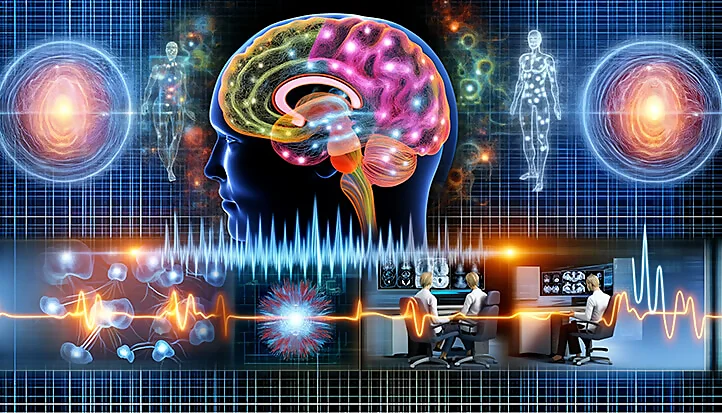Bipolar disorder is a chronic mental illness characterized by significant mood swings that can greatly exceed the usual emotional range between joy and sadness, shifting from manic or hypomanic states (elevated mood and maximum energy) to episodes of deep depression, accompanied by decreased motivation and a lack of interest in life.
The history of studying bipolar disorder dates back to ancient times. As early as the time of Hippocrates, who lived in the 4th century BCE, there were descriptions of conditions resembling mania and depression. However, the concept of bipolar disorder, as we understand it today, began to form much later.
In the 19th century, French psychiatrist Jean-Pierre Falret described circular insanity (cyclothymia), which involved alternating manic and depressive phases. Later, in the late 19th and early 20th centuries, German psychiatrist Emil Kraepelin conducted a detailed differentiation of manic-depressive psychosis (as he called bipolar disorder) from schizophrenia, which had a tremendous impact on the understanding and classification of mental disorders.
The mid-20th century marked a turning point when Australian psychiatrist John Cade discovered the effectiveness of lithium in treating manic states, laying the foundation for modern pharmacotherapy of bipolar disorder. This period also saw the further development of disorder classification, with a refinement of its types and forms.
By the 21st century, research into bipolar disorder had advanced significantly thanks to the use of cutting-edge technologies, such as neuroimaging and molecular genetics.
Thus, the history of studying bipolar disorder reflects the evolution of medical science and treatment approaches, specifically the shift from early observations to comprehensive multidisciplinary research and innovative treatment methods.

Causes of Bipolar Disorder
Bipolar disorder remains one of the most enigmatic and complex mental illnesses to understand. Contrary to popular belief, it is not just about mood swings but is deeply rooted in human biology and psychology. Attempts to decipher the nature of this illness have been ongoing for many decades, attracting the attention of not only medical professionals but also the general public.
Today, scientists agree that the causes of bipolar disorder are multifactorial, including both genetic and environmental components. The complexity of the disorder lies in the fact that it does not have a single cause, but rather results from the interaction of various biological and social factors. This interaction makes each case of bipolar disorder unique, requiring an individual approach to diagnosis and treatment.
Despite significant progress in studying bipolar disorder, the mechanisms that trigger and sustain mood cycles remain partially unexplored. However, thanks to ongoing research, scientists are gradually unlocking the secrets of this complex disorder, which may eventually lead to the development of more effective treatments and preventive measures.
Genetic Factors
Genetic factors play a significant role in the development of bipolar disorder, as evidenced by numerous studies and clinical observations. Research on families with a history of bipolar disorder shows that the risk of developing the illness is much higher among first-degree relatives — children, brothers, or sisters of those affected.
Genetic predisposition to bipolar disorder does not guarantee its development in a specific individual but indicates a higher risk compared to the general population. Studies of twins, including identical ones raised apart, also confirm a significant genetic influence. If one identical twin has bipolar disorder, the likelihood that the other twin will also develop the condition is much higher than in non-identical twins.
Modern genetic research is focused on identifying specific genes that may be linked to the development of bipolar disorder. Although some genetic markers have already been discovered, it is believed that the disorder is not associated with a single gene. Instead, bipolar disorder is likely the result of complex interactions between multiple genes, each contributing a small amount to the overall risk of the illness, as well as interactions between these genetic factors and environmental influences and life circumstances.
Biochemical Imbalances in the Brain
Biochemical imbalances in the brain play a crucial role in the development of bipolar disorder. These imbalances primarily involve the disruption of neurotransmitters — the chemicals that transmit signals between nerve cells in the brain. A disturbance in their balance can lead to significant mood, energy, and behavior changes characteristic of bipolar disorder.
One key theory explaining the mechanism of bipolar disorder is the monoamine theory. According to this theory, mood swings may be caused by changes in the levels of monoamines, such as serotonin, norepinephrine, and dopamine, in different parts of the brain. For example, low levels of serotonin may contribute to depressive states, while an excess of norepinephrine may be associated with manic episodes.
Additionally, research shows that in the brains of people with bipolar disorder, there are changes in the functioning of specific signaling pathways that affect mood regulation. These biochemical changes may be linked to both genetic predisposition and external factors such as stress or trauma.
Other studies suggest a possible role for disruptions in the glutamate metabolism system, the brain’s main excitatory neurotransmitter, and GABA, the central nervous system’s primary inhibitory neurotransmitter, which may also contribute to the development of bipolar disorder.
Understanding the biochemical imbalances underlying bipolar disorder opens the door to developing new and more effective treatment methods aimed at correcting these imbalances at the molecular and cellular levels. This includes creating new medications that more precisely target neurotransmitter imbalances and other biochemical disturbances, thus improving the quality of life for people with bipolar disorder.
Environmental Influence and Stressful Situations
The influence of the environment and stress on the development and course of bipolar disorder is significant. Although genetic predisposition plays an important role in the risk of developing this condition, environmental factors and life circumstances can greatly affect its onset and severity.
Stressful events, such as the loss of a loved one, divorce, difficulties at work or school, often precede the onset or recurrence of bipolar disorder. These events can act as triggers, triggering manic or depressive episodes in people predisposed to the illness.
Besides stress, other environmental factors, such as seasonal changes, substance abuse, and even a lack of sunlight, can also influence the condition of individuals with bipolar disorder. For instance, depressive episodes may intensify during the fall-winter season for some individuals.
Furthermore, the social and psychological environment, including family relationships and social support, significantly impacts the course of bipolar disorder. A supportive environment can aid in quicker recovery and reduce the frequency of relapses, while conflictual or toxic relationships may worsen the individual’s condition.
The interaction of genetic, biochemical, and environmental factors in the development of bipolar disorder underscores the need for a comprehensive approach to treating and supporting people with this illness. Considering external factors and stressful situations is crucial not only for understanding the mechanisms of the disorder but also for developing effective treatment and prevention strategies.

Symptoms and Diagnosis
Bipolar disorder is surrounded by numerous misconceptions and stereotypes, especially when it comes to its symptoms and diagnosis. Understanding the fine line between normal mood swings and those that require professional attention is key to seeking timely help. The symptoms of bipolar disorder can vary significantly from person to person, making its diagnosis a complex but exciting process for medical professionals.
Each episode, whether manic or depressive, has its unique features that may manifest in changes in behavior, thinking, and general perception of the world. Understanding these symptoms requires not only deep knowledge in psychiatry but also the ability to listen carefully and observe the patient.
Diagnosing bipolar disorder is a process that requires time and careful analysis of the patient’s medical history, both subjective and objective. In this context, it is important not only to identify the symptoms but also to understand their impact on the person’s life, as well as to distinguish bipolar disorder from other mental illnesses with similar symptomatology.
Thus, the diagnosis of bipolar disorder becomes an art that requires a high level of professionalism, empathy, and a willingness to delve deep into each unique case.
Manic Phase
The manic phase of bipolar disorder is a period when a person experiences elevated mood, a surge of energy, and increased activity. This period can last from a few days to several weeks and is characterized by the following key signs:
- Elevated mood. A person may feel unusually happy, uplifted, or even euphoric without any apparent reason.
- Increased energy and activity. There is a significant rise in energy levels and physical activity. The person may engage in multiple projects at once or become more actively involved in social life.
- Rapid thinking and speech. Thoughts may race, sometimes so fast that it is difficult to keep up with them. Speech becomes faster, and the mind is filled with ideas.
- Decreased need for sleep. The person may feel full of energy after only a few hours of sleep or may not feel tired at all despite a clear lack of rest.
- Increased self-esteem or grandiose plans. During the manic phase, people may have an unrealistically high self-esteem, believe in their extraordinary abilities, or make unrealistic plans.
- Impulsive or risky behavior. This can include reckless financial investments, impulsive shopping, sexual adventures, or substance abuse.
- Irritability. In some cases, the manic phase may be accompanied by increased irritability, impatience, and hostility, especially if others try to limit the person’s activity or challenge their ideas.
The manic phase of bipolar disorder requires timely medical intervention as it can lead to serious consequences both for the individual and their environment. Treatment usually includes medication and psychotherapeutic support to stabilize mood and prevent further episodes.
Depressive Phase
The depressive phase of bipolar disorder is characterized by a deep sense of sadness, hopelessness, and loss of interest in usual activities and pleasures. This period can last from several weeks to several months and involves various symptoms that can severely affect the person’s daily life. The main signs of the depressive phase include:
- Low mood. The person may feel sad, melancholic, or empty. Their emotional state becomes heavy and suppressed, making it difficult to enjoy life.
- Loss of interest. A significant decrease in interest or pleasure in activities that previously brought joy, including hobbies, social interactions, and even close relationships.
- Changes in appetite and weight. There may be significant changes in appetite, leading to weight loss or gain without dieting or physical exercise.
- Sleep disturbances. Common problems include insomnia, excessive daytime sleepiness, or early morning awakening.
- Fatigue and lack of energy. A constant feeling of tiredness and lack of energy, even for small tasks or decision-making.
- Feelings of guilt and worthlessness. Intrusive thoughts of personal inadequacy, guilt, or shame about past actions and decisions.
- Reduced concentration and inability to make decisions. Difficulty focusing, remembering information, and making decisions.
- Thoughts of death or suicide. The appearance of thoughts about death, self-harm, or suicide.
The depressive phase of bipolar disorder requires professional treatment and support. This may include medication to stabilize mood, as well as psychotherapy to develop strategies for managing stress, restoring self-esteem, and improving overall quality of life. It is crucial that people with bipolar disorder receive timely and effective help to manage both manic and depressive phases of the condition.
Methods of Diagnosing Bipolar Disorder
Diagnosing bipolar disorder is a complex process that requires careful analysis of the patient’s medical history, symptoms, and the exclusion of other medical and psychiatric conditions that may mimic bipolar disorder. Here are several key diagnostic methods used in medical practice:
- Clinical interview and self-assessment. The first step usually involves a detailed interview with the patient and their relatives about symptoms, medical history, and any cases of mental disorders in the family. Patients may also be offered questionnaires or self-assessment scales to evaluate the severity of symptoms.
- Psychiatric evaluation. The psychiatrist conducts an assessment of the patient’s mental state to identify signs of manic, hypomanic, or depressive episodes, as well as to evaluate behavior, thinking, and mood.
- Medical tests. To rule out other medical causes of symptoms, such as hormonal imbalances or neurological disorders, blood tests, brain MRI, or other diagnostic procedures may be ordered.
- Mood diary. Patients may be asked to keep a mood diary, where they record their daily emotional states and other important changes. This helps the doctor better understand the dynamics and cycles of mood swings.
- Exclusion of other mental disorders. It is important to differentiate bipolar disorder from other mental illnesses and conditions, such as clinical depression, schizophrenia, anhedonia, or borderline personality disorder, as their symptoms may overlap.
- Diagnostic criteria according to DSM-5 or ICD-10. Standardized criteria outlined in the Diagnostic and Statistical Manual of Mental Disorders (DSM-5) or the International Classification of Diseases (ICD-10) are used for the final diagnosis, including specific indicators for manic, hypomanic, and depressive episodes.
Differential Diagnosis
Differential diagnosis of bipolar disorder is important to distinguish it from other mental illnesses that have similar symptoms. This approach ensures the most appropriate treatment and support. Here are some conditions that should be considered when differentiating bipolar disorder:
- Major depressive disorder (MDD) is characterized by depressive episodes, but unlike bipolar disorder, it does not include manic or hypomanic phases. Identifying episodes of elevated mood is essential for accurate diagnosis.
- Personality disorders. Some traits of personality disorders, especially borderline personality disorder (BPD), may resemble bipolar disorder. BPD may include mood swings, impulsive behavior, and unstable interpersonal relationships. However, mood changes in BPD are usually more short-lived and often triggered by interpersonal conflicts.
- Schizoaffective disorder combines symptoms of schizophrenia (such as hallucinations or delusions) and mood disorder symptoms (depression or mania). Differentiation requires careful analysis of the medical history and symptoms.
- Substance-induced mood disorder. Some substances, including alcohol, drugs, and medications, can cause manic or depressive symptoms. A history of substance use should be clarified for proper diagnosis.
- Cyclothymic disorder is characterized by alternating hypomanic and mild depressive episodes without full manic or clinical depression.
- Seasonal affective disorder (SAD) manifests with seasonal depressive episodes, usually in winter, which distinguishes it from bipolar disorder, where depressive and manic episodes can occur at any time of the year.
Differential diagnosis requires a comprehensive approach, including a detailed medical and psychiatric history, as well as additional medical tests if necessary.

Types of Bipolar Disorder
Bipolar disorder, with its diverse manifestations and profound impact on an individual’s life, has long attracted the attention of researchers and clinicians. Over time, it has become evident that this condition is not monolithic; it encompasses a wide range of states, each with its own distinct features. The different types of bipolar disorder reflect unique combinations and intensities of symptoms, which, in turn, require individualized approaches to treatment and support.
Understanding the diversity of bipolar disorder is crucial for developing the most effective treatment strategies and providing adequate support for those who face it. It also helps break the stigma surrounding mental disorders by giving society a deeper understanding of what it means to live with such a condition.
In a world where awareness of mental health is growing and the taboo around mental disorders is gradually weakening, knowledge about the various types of bipolar disorder becomes an essential tool. It not only contributes to more accurate diagnosis and treatment but also fosters the creation of a more inclusive society that is ready to accept and support individuals with any type of bipolar disorder. Ultimately, a deeper understanding of the differences between these types can shed light on many aspects of the lives of those affected by bipolar disorder.
Bipolar Disorder Type I
Bipolar disorder type I is one of the primary forms of bipolar disorder, characterized by the presence of one or more manic episodes. These manic periods often alternate with episodes of major depressive disorder, although depressive episodes are not a mandatory criterion for diagnosis. The key distinguishing feature of bipolar disorder type I is the manic episode, which can lead to significant disruptions in a person’s work, social life, and daily activities.
A manic episode in the context of bipolar disorder type I is characterized by an elevated, excessively good, or irritable mood lasting for at least one week. During this time, the person may experience increased energy or activity, reduced need for sleep, accelerated thinking or speech, inflated self-esteem, heightened risk-taking behavior, and other symptoms that significantly differ from their usual behavior.
The diagnosis of bipolar disorder type I requires a thorough medical history, including information from close ones who can confirm changes in behavior and mood. The diagnosis is based on clinical criteria outlined in medical manuals such as the Diagnostic and Statistical Manual of Mental Disorders (DSM) or the International Classification of Diseases (ICD). A crucial part of the diagnostic process involves ruling out other medical causes for the symptoms and differentiating from other mental disorders.
Treatment for bipolar disorder type I typically involves a combination of medication and psychotherapy. Medication may include mood stabilizers, antipsychotics, and, in some cases, antidepressants to manage depressive episodes. Psychotherapeutic approaches, such as cognitive-behavioral therapy (CBT), focus on developing stress-coping strategies, improving interpersonal relationships, and preventing future episodes.
Bipolar Disorder Type II
Bipolar disorder type II is a form of bipolar disorder characterized by one or more episodes of major depressive disorder, accompanied by at least one hypomanic episode. Unlike bipolar disorder type I, where full-blown manic episodes occur, bipolar disorder type II does not include highly severe manic states, which sometimes complicates its diagnosis.
Hypomanic episodes in the context of bipolar disorder type II can manifest through elevated mood or irritability, increased energy and activity, accelerated thinking and speech, reduced need for sleep, inflated self-esteem, and a heightened tendency for risk-taking behavior, but these symptoms do not reach a severity that would cause significant social or professional issues.
The diagnosis of bipolar disorder type II requires careful history-taking and symptom evaluation, as well as ruling out other psychiatric disorders and medical conditions that may mimic its symptoms. It’s important to note that depressive episodes in bipolar disorder type II are often longer and more intense compared to hypomanic episodes, which can lead to an overemphasis on depression during diagnosis.
Treatment for bipolar disorder type II is similar to that of type I, involving a comprehensive approach with the use of medication, psychotherapy, and support from family and friends.
Cyclothymia
Cyclothymia, also known as cyclothymic disorder, is a milder form of bipolar disorder characterized by alternating periods of mild depressive states and hypomania. These mood changes do not reach the full extent of manic or major depressive episodes seen in bipolar disorder types I and II, but they are pronounced enough to affect a person’s quality of life and require professional attention.
The symptoms of cyclothymia may be less intense, but they are long-lasting and persistent, often lasting for several years. People with cyclothymia experience periods of elevated mood, energy, and productivity, followed by phases of low mood, decreased energy, and a lack of interest in everyday activities. The key feature is that despite these mood swings, they are not severe enough to qualify as full-blown manic or depressive episodes, and they rarely cause serious disruptions in social, academic, or work activities.
Diagnosing cyclothymia requires careful monitoring of mood and behavior changes for at least two years in adults and one year in children and adolescents. It is important to rule out other medical conditions and mental disorders that present similar symptoms to cyclothymia.
Treatment for cyclothymia may include medication, as well as psychotherapeutic methods aimed at improving stress-coping strategies, developing interpersonal communication skills, and managing mood swings.
Despite its apparent mildness, cyclothymia requires a careful approach to treatment and support, as it can significantly impact a person’s life and, in some cases, progress to bipolar disorder type I or II.
Mixed Episodes
Mixed episodes in the context of bipolar disorder represent states where symptoms of mania and depression occur simultaneously or alternate almost daily for at least one week. This means a person may feel a surge of energy and heightened activity, characteristic of a manic state, while simultaneously experiencing feelings of sadness, hopelessness, or other depressive symptoms. Mixed episodes are particularly challenging to endure, as the combination of opposing moods creates significant psychological tension.
Individuals experiencing mixed episodes may feel highly irritable and anxious. They often have trouble concentrating, suffer from sleep disturbances, excessive activity, sudden outbursts of anger or tearfulness, and even suicidal thoughts. This condition is particularly dangerous due to the increased risk of suicidal behavior and the need for immediate medical intervention.
The diagnosis of mixed episodes requires thorough clinical evaluation, including a detailed medical history and mental health assessment. It is essential to distinguish mixed episodes from other psychiatric disorders that may present similar symptoms.
Treatment for mixed episodes typically involves the use of mood stabilizers such as lithium, valproic acid, or lamotrigine, as well as antipsychotic medications to manage symptoms. In some cases, antidepressants may be prescribed, though their use must be approached with caution due to the risk of triggering manic symptoms. Psychotherapy, including cognitive-behavioral therapy and family therapy, can also be an effective part of a comprehensive treatment plan, helping the patient develop stress-coping strategies and improve interpersonal skills.
Mixed episodes require special attention from both healthcare providers and close ones, as they can significantly affect a person’s functioning and pose a threat to their safety.

Treatment of Bipolar Disorder
Treating bipolar disorder is a complex and multifaceted process aimed at managing symptoms, preventing new episodes, and improving the overall quality of life for patients. Given the variability and cyclical nature of bipolar disorder, the approach to treatment requires a deep understanding of the individual characteristics of each case, as well as flexibility and adaptability of strategies depending on the person’s current condition.
Modern medicine offers a wide range of treatment methods, including medication therapy, psychotherapeutic interventions, supportive measures, and family work. A key aspect of successful treatment is a comprehensive approach that combines various types of interventions to achieve the best results.
It is important to note that the treatment of bipolar disorder is not only aimed at alleviating current symptoms but also at long-term management of the disorder, which includes strategies for preventing relapses and maintaining mood stability. This requires the patient’s active involvement in the treatment process, including following the doctor’s recommendations, taking medications regularly, and participating in psychotherapy sessions.
On the path to improving the condition of those with bipolar disorder, support from family, educational programs, and society plays a crucial role. Creating a supportive environment and reducing the stigma associated with mental illness contribute to more effective treatment and rehabilitation of patients.
Medication Treatment
Medication treatment for bipolar disorder involves the use of various groups of medications aimed at stabilizing mood, reducing the frequency and severity of manic and depressive episodes, and preventing future relapses. The main groups of medications used in treatment include:
- Mood stabilizers. Lithium is considered one of the most effective mood stabilizers used to treat both manic and depressive episodes. Valproic acid (valproate) and carbamazepine are also used for mood stabilization.
- Antipsychotic medications. Atypical antipsychotics, such as quetiapine, olanzapine, and risperidone, may be prescribed to manage symptoms of mania or mixed episodes, as well as adjunctive therapy for depression.
- Antidepressants are used with caution and usually in combination with mood stabilizers to prevent a possible switch to mania. Selective serotonin reuptake inhibitors (SSRIs) or serotonin-norepinephrine reuptake inhibitors (SNRIs) may be prescribed due to their relative safety and tolerability.
- Benzodiazepines. Short-term use of benzodiazepines such as clonazepam or lorazepam can be effective in reducing anxiety, irritability, or insomnia during manic or mixed episodes.
The choice of a specific medication or combination of medications depends on many factors, including the type of bipolar disorder, current symptoms, the patient’s medical history, and the presence of comorbid conditions. An important aspect of medication treatment is close collaboration between the patient and the doctor to monitor medication effectiveness, assess side effects, and adjust therapy as needed.
Psychotherapy
Psychotherapy is a key component of comprehensive treatment for bipolar disorder. It helps patients better understand their condition, develop stress management skills, improve interpersonal relationships, and enhance their quality of life. Here are some main types of psychotherapy used in treating bipolar disorder:
- Cognitive-behavioral therapy (CBT) helps identify and change negative thinking patterns and behaviors that may contribute to bipolar episodes. Patients learn to recognize the signs of episodes and apply strategies to manage symptoms.
- Interpersonal and Social Rhythm Therapy (IPSRT) focuses on stabilizing daily rhythms such as sleep, eating, and physical activity. IPSRT also helps improve interpersonal relationships that may be affected during bipolar disorder.
- Family-focused therapy involves family members in the treatment process, helping them understand the nature of bipolar disorder and develop more effective ways to support the patient. Family therapy also aims to improve communication and resolve conflicts within the family.
- Psychoeducation programs provide patients and their families with important information about bipolar disorder, its treatment, and management strategies. Educating patients helps them become more active participants in the treatment process and increases their chances of successful recovery.
- Group therapy allows patients to share their experiences with others facing similar problems and find support and understanding in the community. Group therapy is especially useful for developing social skills and reducing feelings of isolation.
The choice of the appropriate type of psychotherapy depends on the individual needs of the patient, their preferences, and specific treatment goals. In many cases, a combination of different types of psychotherapy with medication treatment yields the best results in managing bipolar disorder.
Electroconvulsive Therapy (ECT) and Other Methods
Electroconvulsive therapy (ECT) is one of the most effective treatments for severe episodes of bipolar disorder, especially when standard medication therapy does not yield the expected results or when there is a need for rapid symptom relief. ECT is performed by delivering controlled electrical impulses through the brain under general anesthesia, causing short-term seizures. The procedure helps to quickly reduce symptoms of severe depression, mania, or mixed episodes.
In addition to ECT, other methods can be used in the treatment of bipolar disorder, including:
- Transcranial Magnetic Stimulation (TMS). This non-invasive method uses magnetic pulses directed to specific areas of the brain to stimulate nerve cells. TMS can be used to treat the depressive phase of bipolar disorder.
- Deep Brain Stimulation (DBS). This method involves the surgical implantation of electrodes in certain areas of the brain, which are then stimulated by electrical impulses. DBS is used for severe cases of bipolar disorder that are resistant to other treatments.
- Light therapy, which is particularly effective for treating seasonal affective depression associated with bipolar disorder. Light therapy involves regular exposure to bright light under controlled conditions.
- Psychosocial interventions. In addition to psychotherapy, social rehabilitation, vocational guidance, and family and societal support play an important role in treatment. These interventions are aimed at improving functioning and quality of life for patients.
- Omega-3 fatty acids. Some studies suggest that omega-3 fatty acid supplements may have a positive effect on mood and serve as an adjunctive treatment for bipolar disorder.

Prevention of Exacerbations
Preventing exacerbations of bipolar disorder plays a critically important role in managing the condition. Given its cyclical nature and tendency to repeat episodes of mania or depression, developing strategies to minimize the risk of new episodes becomes an integral part of a long-term treatment plan. Effective prevention not only improves patients’ immediate well-being but also enhances their social and professional adaptation, eases interpersonal relationships, and contributes to a more fulfilling and happier life overall.
The importance of preventive measures is also due to the fact that each new episode can worsen the course of the illness, making subsequent episodes more severe and reducing treatment efficacy. Therefore, focusing on preventing exacerbations helps not only reduce the frequency and intensity of episodes but also preserves cognitive function and overall physical health.
Creating an individualized prevention plan requires a deep understanding of the nature of bipolar disorder, its triggers, and warning signs of a new episode. In this process, collaboration between the patient, their family, and medical professionals plays an important role, allowing for the creation of a supportive environment and ensuring the necessary help at all stages of the condition.
Daily Routine and Nutrition
A daily routine and balanced nutrition play important roles in preventing exacerbations of bipolar disorder. A stable schedule of daily activities, including regular meals, sleep times, and physical exercise, helps maintain the body’s biological rhythms, reducing the likelihood of new episodes.
Maintaining a daily routine strengthens circadian rhythms, which is especially important for people with bipolar disorder, where sleep disturbances often precede exacerbations. Establishing a fixed time for sleep and waking, even on weekends, improves sleep quality and overall well-being.
Balanced nutrition also has a significant impact on managing bipolar disorder. A diet rich in omega-3 fatty acids, whole grains, fresh fruits, and vegetables contributes to mood stabilization. It is important to avoid or limit caffeine and alcohol consumption, as they can disrupt sleep and trigger mood changes.
It is also recommended to engage in regular physical activity, which boosts the production of endorphins, improves mood, and reduces stress levels. Even light activities, such as daily walks in the fresh air, have a positive effect on emotional well-being.
Creating and maintaining a structured daily routine and balanced diet requires time and effort, but they are important components of a comprehensive approach to managing bipolar disorder and preventing exacerbations.
Stress Management
Stress management is a key element in preventing exacerbations of bipolar disorder. Stress often serves as a trigger for new episodes of mania or depression, so learning to effectively cope with stressful situations and reduce stress levels in daily life is crucial for people suffering from this condition.
One way to manage stress is to develop relaxation skills such as breathing exercises, meditation, yoga, or progressive muscle relaxation. These methods help reduce physical and emotional tension, improve concentration, and promote overall calmness.
It is also important to develop time management skills and prioritize tasks to avoid overload and stressful situations. Setting realistic goals and breaking large tasks into smaller steps helps manage feelings of being overwhelmed and improves time management.
Social support plays a significant role in stress management. Communication with friends, family, or participation in support groups provides emotional relief and additional resources to cope with stress. It is important to surround yourself with people who understand the issue and can offer support.
Professional assistance, including consultations with a psychologist, may be necessary to develop individual stress management strategies, especially when self-help methods are insufficient. A psychologist can help identify sources of stress, develop strategies for overcoming them, and teach stress-reduction techniques tailored to the specific needs and circumstances of the patient’s life.
In addition to these methods, maintaining a healthy lifestyle, including balanced nutrition, sufficient sleep, and regular physical exercise, contributes to increasing the body’s overall resilience to stress.
The Role of Physical Activity
Physical activity plays a significant role in preventing and managing bipolar disorder exacerbations. Regular exercise not only improves physical health but also has a positive effect on mental well-being, helping reduce the frequency and intensity of episodes of depression and mania. Here are several key aspects that highlight the importance of physical activity in managing bipolar disorder:
- Improving mood. Physical exercises stimulate the production of endorphins, known as “happiness hormones,” which contribute to mood improvement and overall well-being.
- Reducing stress. Regular physical activity helps reduce stress and anxiety by lowering levels of stress hormones in the body, such as cortisol.
- Improving sleep quality. Physical activity helps normalize sleep-wake rhythms, which is especially important for people with bipolar disorder who often experience sleep problems.
- Increasing energy and improving physical health. Physical exercises boost energy levels and endurance, improve heart health, and reduce the risk of developing diabetes and obesity, which also positively impacts managing bipolar disorder symptoms.
- Stabilizing biorhythms. Regular physical activity helps stabilize circadian rhythms, which may reduce the likelihood of manic or depressive episodes.
- Boosting self-esteem and social integration. Participating in sports activities and group exercise improves self-esteem and provides social support through interaction with others.
Daily physical activity, whether walking, yoga, swimming, cycling, or gym workouts, can be adapted to individual preferences and capabilities. Before starting any exercise program, consult with your healthcare provider, especially if you have other medical conditions or limitations.

Living with Bipolar Disorder
Living with bipolar disorder is a journey filled with challenges and discoveries, requiring deep understanding, patience, and adaptation from both the individual and their surroundings. This condition, which affects emotional range, energy, and perception of the world, requires a comprehensive approach to management and support at every stage.
People dealing with bipolar disorder often explore the boundaries of their emotions and learn to find a balance between the highs and lows of their mood. Along this path, they develop skills to recognize early signs of mood shifts, devise stress management strategies, and build strong supportive relationships with loved ones and medical professionals.
A crucial aspect of living with bipolar disorder is building self-esteem and confidence, despite potential difficulties. Accepting the diagnosis and actively participating in the treatment process become key factors in successful adaptation and achieving stability.
On the path to improving quality of life, individuals with bipolar disorder find that a balanced diet, regular physical activity, adequate rest, and stress management play an important role in maintaining emotional balance. Openness and communication about their condition also help reduce stigma and build a supportive community around them.
Thus, living with bipolar disorder becomes not only about managing symptoms but also a journey of self-discovery, self-acceptance, and finding harmony within oneself and in relationships with the world.
Self-help Strategies
Self-help strategies play a crucial role in managing bipolar disorder by helping to reduce the frequency and severity of episodes, as well as improving the overall quality of life. Here are the key strategies:
- Developing a regular daily routine. Maintaining a consistent routine helps stabilize mood. It is important to follow a regular schedule of sleep, meals, and physical activity.
- Monitoring mood. Keeping a mood diary helps track changes and recognize early warning signs of episodes. This allows for timely action to prevent exacerbations.
- Developing stress management strategies. Relaxation techniques, meditation, breathing exercises, and yoga help reduce stress and anxiety.
- Maintaining a healthy lifestyle. A balanced diet, regular physical exercise, and avoiding harmful habits such as alcohol and drug use contribute to overall health and symptom management.
- Social support. Communication with friends, family, and participation in support groups provide emotional backing and help cope with challenges.
- Education and awareness. Learning about bipolar disorder helps better understand the condition and choose effective management strategies.
- Working with triggers. Identifying and minimizing the impact of triggers such as stress, lack of sleep, or alcohol use can help prevent new episodes.
- Professional assistance. Don’t hesitate to seek professional medical help when needed. Regular visits to a psychologist, psychotherapist or psychiatrist help control the condition and adjust the treatment plan.
Support from Family and Friends
Support from family and friends plays a critical role in the lives of people with bipolar disorder. Understanding and involvement from loved ones can significantly ease the process of managing the condition and contribute to quicker recovery. Here are several ways in which family and friends can provide support:
- Education. It’s important to learn as much as possible about bipolar disorder to understand what the person is going through, their needs, and how their condition affects behavior and mood.
- Providing a safe space. Creating an atmosphere of openness and trust, where the person can express their feelings and experiences without fear of being judged or misunderstood.
- Helping follow the treatment plan. Support in adhering to the treatment regime, reminding the person to take medications and attend medical appointments can greatly improve treatment outcomes.
- Monitoring warning signs. Loved ones can help recognize early signs of exacerbation and seek medical help in a timely manner.
- Maintaining routine. Assisting in maintaining a regular daily routine, including healthy sleep, meals, and physical activity, helps stabilize mood.
- Moral support. Simply expressing empathy, understanding, and readiness to support at every stage of treatment is crucial for a person with bipolar disorder.
- Participating in psychotherapy. If necessary, family can join family therapy or psychological consultations to better understand how to support their loved one and cope with their own feelings.
Support from loved ones not only helps reduce the feeling of isolation and loneliness for a person with bipolar disorder but also contributes to creating a stable and supportive environment necessary for successful recovery and condition management.
Social Adaptation and Work
Social adaptation and successful integration into the workplace are significant aspects of the lives of people with bipolar disorder. These factors play an important role in the process of recovery and maintaining stability. For individuals facing bipolar disorder, social adaptation and work may present certain challenges, but with the right support and management strategies, these tasks become entirely achievable.
- Establishing a stable daily routine, including regular wake-up and bedtime, helps stabilize mood and improve overall well-being. This is especially important for maintaining effectiveness at work and in social activities.
- Disclosing one’s condition at work is a personal choice. In some cases, discussing adaptations or a flexible schedule with the employer can be helpful in ensuring a productive work environment.
- Developing stress management strategies is crucial since stress can trigger bipolar episodes. Relaxation techniques, time for rest and hobbies, as well as physical exercise, help reduce stress levels.
- Building supportive relationships at work and in the social sphere helps create a support network, which is important for anyone, especially for those facing mental health issues. Friends, family, and colleagues can offer the necessary support and understanding.
- Professional development and education also play a key role. Participating in courses, trainings, and other educational activities helps improve professional skills and boost self-esteem.
- Seeking professional help, such as career counseling or psychotherapy services, is beneficial for overcoming challenges in social adaptation and at the workplace.
Social adaptation and involvement in work take time and effort, especially for individuals with bipolar disorder. However, with the right support and adequate treatment, successful social and professional integration is entirely achievable.

Debunking Myths about Bipolar Disorder
There are many myths and misconceptions surrounding bipolar disorder that can distort how this condition is perceived by society and even by those who suffer from it. Misunderstanding the nature of bipolar disorder, its symptoms, and methods of treatment leads to stigmatization, isolation, and reluctance to seek help. Meanwhile, knowledge and awareness of the realities of this condition can significantly improve the quality of life for people living with bipolar disorder and their loved ones.
Debunking myths about bipolar disorder starts with spreading accurate information and educating the public. This includes clarifying the differences between normal mood swings and clinical episodes of bipolar disorder, emphasizing the importance of medical diagnosis and treatment, and dispelling stereotypes associated with this condition.
Acceptance and understanding of bipolar disorder as a serious but manageable condition is a crucial step toward creating a more inclusive and supportive society. This will enable those suffering from it to feel less isolated and more confident in seeking and receiving the necessary help and support.
Here are some of the most common myths:
- Bipolar disorder is just mood swings. Many believe that bipolar disorder simply means frequent mood changes, but it’s much more than ordinary emotional fluctuations. It is a serious mental health condition characterized by significant changes in mood and behavior.
- People with bipolar disorder are always either depressed or euphoric. In reality, there can be periods of stable mood between manic and depressive episodes. A person’s state does not always fluctuate between extremes.
- Bipolar disorder is easy to recognize. Diagnosing bipolar disorder can be challenging due to the similarity of its symptoms to other mental health conditions such as major depressive disorder or borderline personality disorder.
- Bipolar disorder cannot be treated. While bipolar disorder is a chronic condition, there are effective treatments, including medication and psychotherapy, that help manage symptoms and improve the quality of life.
- People with bipolar disorder are unpredictable and dangerous. Stereotypes and media misrepresentations of bipolar disorder can lead to the mistaken belief that all people with this diagnosis are unpredictable or prone to violence. In fact, most people with bipolar disorder lead normal lives and do not pose a danger to others.
- People with bipolar disorder always need hospitalization. Although inpatient care may be necessary in some cases, many people with bipolar disorder successfully manage the condition, leading active and productive lives by following medical advice and receiving support from loved ones.
Debunking these and other misconceptions helps build a deeper and more comprehensive understanding of bipolar disorder, fostering fair and supportive attitudes toward people living with this condition.
The Importance of Public Awareness
Public awareness of bipolar disorder plays a critically important role in breaking down stereotypes and providing support to those who face this condition.
- Reducing stigma. Misunderstanding and biased views about mental health conditions can lead to the stigmatization of people with bipolar disorder. Education and public outreach help debunk myths and shift negative stereotypes, creating a more inclusive and supportive society.
- Raising awareness of symptoms. Understanding the signs and symptoms of bipolar disorder allows people to seek help in a timely manner and start treatment. It also helps friends and family better understand what their loved one is going through and how to support them.
- Promoting knowledge about treatment. Awareness of available treatments and support encourages more active seeking and use of resources for managing the condition. It also helps people make informed decisions about their treatment in collaboration with healthcare providers.
- Support and social integration. Public understanding of what bipolar disorder truly entails promotes the social integration of people living with the condition and reduces their isolation. This creates a more favorable environment for recovery and adaptation.
- Involvement in policy-making. High public awareness can stimulate the development and implementation of policies and support programs aimed at improving the living conditions and treatment of people with bipolar disorder.
- Encouraging research and investment. Public recognition of the importance of bipolar disorder can lead to increased funding for research focused on finding new treatments and a better understanding of this condition.

Bipolar Disorder: Perspectives and Research
In recent years, scientific interest in bipolar disorder has grown significantly, opening new horizons in understanding and treating this complex mental health condition. Research in this field aims at a comprehensive exploration of the mechanisms underlying bipolar disorder, the search for effective treatment methods, and strategies for prevention, as well as improving the quality of life for people affected by this condition.
Current scientific studies cover a wide range of topics, including genetic research, exploring the impact of the environment and lifestyle on the development of bipolar disorder, and the development and testing of new pharmacological and non-pharmacological approaches to treatment. Through the use of advanced technologies such as neuroimaging and molecular biology, scientists are gaining deeper insights into the structural and functional changes in the brain associated with bipolar disorder.
At the same time, an emphasis on multidisciplinary approaches and the integration of knowledge from various fields of science contributes to the creation of comprehensive models for the treatment and support of patients. Research in the field of psychosocial interventions and digital psychiatry opens new possibilities for improving access to treatment and enhancing its effectiveness.
The perspectives and research into bipolar disorder promise significant advancements in the understanding of the condition and the development of individualized treatment approaches, which could radically change the lives of many people living with this condition. Continued scientific developments and their implementation in clinical practice are key factors in achieving these goals.
New Treatment Methods
Research into the treatment of bipolar disorder is constantly ongoing, aiming to improve therapy effectiveness and patient quality of life. New methods include both pharmacological and non-pharmacological approaches. Here are a few examples of innovative directions in the treatment of bipolar disorder:
- Genetic research. Advances in genomics and bioinformatics open new perspectives on understanding the mechanisms behind bipolar disorder. Identifying genetic markers could lead to the development of personalized treatment methods based on the patient’s individual genetic characteristics.
- New pharmacological agents. New medications are emerging that target the neurobiological pathways associated with bipolar disorder. This includes new mood stabilizers, antipsychotics, and antidepressants with improved safety profiles and tolerability.
- Transcranial magnetic stimulation (TMS). This non-invasive treatment method, which uses magnetic fields to stimulate certain brain areas, shows promising results in treating depressive episodes in bipolar disorder.
- Deep brain stimulation (DBS) involves surgically implanting electrodes in specific brain areas for continuous stimulation. This method is being studied as a potential treatment for severe cases of bipolar disorder that are resistant to standard therapy.
- Psychobiome studies. Research on the relationship between gut microbiota and the brain is opening new perspectives on understanding mental health disorders, including bipolar disorder. The development of probiotics and dietary modifications may become new methods for mood regulation.
- Digital technologies. Mobile apps for mood monitoring, psychoeducational web platforms, and telemedicine offer new opportunities for supporting and treating patients with bipolar disorder, providing online access to resources and specialists.
These and other innovations in the treatment of bipolar disorder reflect a multidisciplinary approach to managing the condition, combining medical, psychological, and technological solutions. Progress in research and development promises to improve treatment strategies and provide more effective and safer therapy options for people living with bipolar disorder.

Recommended Reading
- “An Unquiet Mind: A Memoir of Moods and Madness” by Kay Redfield Jamison. This is a memoir by a renowned clinical psychologist, professor, and specialist in bipolar disorder, who herself lives with the condition. The book offers a unique perspective on bipolar disorder, combining personal experience with professional knowledge.
- “Bipolar Disorder: A Guide for Patients and Families” by Francis Mark Mondimore. This book is an accessible guide for patients and their families with extensive information about bipolar disorder, including symptoms, diagnosis, treatment, and disease management strategies.
- “The Bipolar Disorder Survival Guide: What You and Your Family Need to Know” by David J. Miklowitz. This guide offers practical advice and strategies for people with bipolar disorder and their loved ones. It covers aspects of mood management, crisis prevention, and maintaining daily activities.
- “Loving Someone with Bipolar Disorder: Understanding and Helping Your Partner” by Julie A. Fast and John D. Preston. This book is written for partners and close family members dealing with bipolar disorder in their loved ones. It provides tools and strategies for supporting a loved one while maintaining healthy and balanced relationships.
- “Manic-Depressive Illness: Bipolar Disorders and Recurrent Depression” by Frederick K. Goodwin and Kay Redfield Jamison. This extensive academic publication provides a comprehensive overview of bipolar disorder, including its history, clinical manifestations, and treatment approaches. Written by leading experts in the field, the book serves as a valuable resource for professionals as well as students of medical and psychological disciplines.




